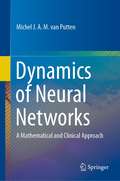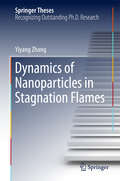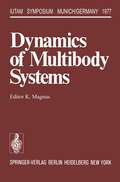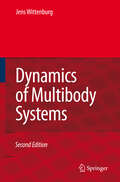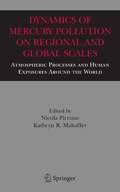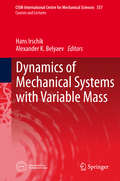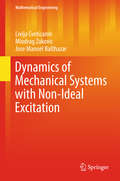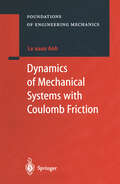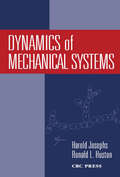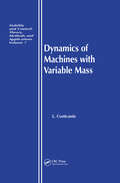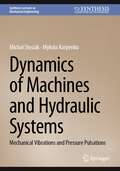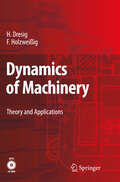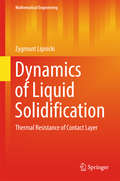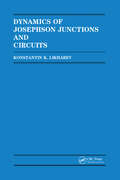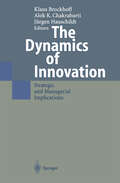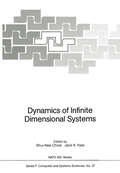- Table View
- List View
Dynamics of Neural Networks: A Mathematical and Clinical Approach
by Michel J.A.M. van PuttenThis book treats essentials from neurophysiology (Hodgkin–Huxley equations, synaptic transmission, prototype networks of neurons) and related mathematical concepts (dimensionality reductions, equilibria, bifurcations, limit cycles and phase plane analysis). This is subsequently applied in a clinical context, focusing on EEG generation, ischaemia, epilepsy and neurostimulation. The book is based on a graduate course taught by clinicians and mathematicians at the Institute of Technical Medicine at the University of Twente. Throughout the text, the author presents examples of neurological disorders in relation to applied mathematics to assist in disclosing various fundamental properties of the clinical reality at hand. Exercises are provided at the end of each chapter; answers are included. Basic knowledge of calculus, linear algebra, differential equations and familiarity with MATLAB or Python is assumed. Also, students should have some understanding of essentials of (clinical) neurophysiology, although most concepts are summarized in the first chapters. The audience includes advanced undergraduate or graduate students in Biomedical Engineering, Technical Medicine and Biology. Applied mathematicians may find pleasure in learning about the neurophysiology and clinic essentials applications. In addition, clinicians with an interest in dynamics of neural networks may find this book useful, too.
Dynamics of Nanoparticles in Stagnation Flames (Springer Theses)
by Yiyang ZhangThis book studies the collision, coalescence and deposition of nanoparticles in stagnation flames. With the help of synthesis experiments, in-situ laser diagnostics and molecular dynamics simulations, it investigates the growth of nanoparticles in flames and their deposition in boundary layers at a macroscopic flow field scale, as well as particle and molecular scale issues such as the interaction force between particles, how the collision rate is enhanced by attractive forces, and how the nano-scale coalescence process is influenced by the high surface curvature – all of which are crucial to understanding nanoparticle transport phenomena at high temperatures. The book also reports on a novel in-situ laser diagnostics phenomenon called phase-selective laser-induced breakdown spectroscopy and related applications for tracing gas-to-particle transitions and measuring local particle volume fractions in nano-aerosols.
Dynamics of Multibody Systems: Symposium Munich/Germany August 29–September 3, 1977 (IUTAM Symposia)
by K. MagnusDynamics of Multibody Systems
by Robert E. Roberson Richard SchwertassekMultibody systems are the appropriate models for predicting and evaluating performance of a variety of dynamical systems such as spacecraft, vehicles, mechanisms, robots or biomechanical systems. This book adresses the general problem of analysing the behaviour of such multibody systems by digital simulation. This implies that pre-computer analytical methods for deriving the system equations must be replaced by systematic computer oriented formalisms, which can be translated conveniently into efficient computer codes for - generating the system equations based on simple user data describing the system model - solving those complex equations yielding results ready for design evaluation. Emphasis is on computer based derivation of the system equations thus freeing the user from the time consuming and error-prone task of developing equations of motion for various problems again and again.
Dynamics of Multibody Systems
by Jens WittenburgThank heavens for Jens Wittenburg, of the University of Karlsruhe in Germany. Anyone who’s been laboring for years over equation after equation will want to give him a great big hug. It is common practice to develop equations for each system separately and to consider the labor necessary for deriving all of these as inevitable. Not so, says the author. Here, he takes it upon himself to describe in detail a formalism which substantially simplifies these tasks.
Dynamics of Mobile Systems with Controlled Configuration
by Felix Chernousko Nikolay BolotnikThe book discusses the dynamics and control of motion for mobile robots and other systems capable of moving in various environments by modifying their configurations. It is intended for researchers and engineers in theoretical and applied mechanics, robotics, control theory, and biomechanics. Additionally, graduate and post-graduate students studying these disciplines will find it a useful resource.
Dynamics of Microelectromechanical Systems (Microsystems #17)
by Nicolae LobontiuHere is a textbook for senior undergraduate and graduate level students that offers a novel and systematic look into the dynamics of MEMS. It includes numerous solved examples together with the proposed problems. The material to be found here will also be of interest to researchers with a non-mechanical background. The book focuses on the mechanical domain, specifically the dynamic sub-domain, and provides an in-depth treatment of problems that involve reliable modeling, analysis and design.
Dynamics of Mercury Pollution on Regional and Global Scales: Atmospheric Processes and Human Exposures Around the World
by Nicola Pirrone Kathryn R. MahaffeyThis book provides a comprehensive overview of the different dynamic patterns involved in the redistribution of mercury in the global environment, and its impact on human health and ecosystems. Increasing mercury usage and the lack of emission control policy, especially in fast developing countries, represent a complex environmental and political issue that can only benefit from more accurate measurement.
Dynamics of Mechanical Systems with Variable Mass (CISM International Centre for Mechanical Sciences #557)
by Hans Irschik Alexander K. Belyaev International Centre for Mechanical Sciences StaffThe book presents up-to-date and unifying formulations for treating dynamics of different types of mechanical systems with variable mass. The starting point is overview of the continuum mechanics relations of balance and jump for open systems from which extended Lagrange and Hamiltonian formulations are derived. Corresponding approaches are stated at the level of analytical mechanics with emphasis on systems with a position-dependent mass and at the level of structural mechanics. Special emphasis is laid upon axially moving structures like belts and chains and on pipes with an axial flow of fluid. Constitutive relations in the dynamics of systems with variable mass are studied with particular reference to modeling of multi-component mixtures. The dynamics of machines with a variable mass are treated in detail and conservation laws and the stability of motion will be analyzed. Novel finite element formulations for open systems in coupled fluid and structural dynamics are presented.
Dynamics of Mechanical Systems with Non-Ideal Excitation (Mathematical Engineering)
by Livija Cveticanin Miodrag Zukovic Jose Manoel BalthazarIn this book the dynamics of the non-ideal oscillatory system, in which the excitation is influenced by the response of the oscillator, is presented. Linear and nonlinear oscillators with one or more degrees of freedom interacting with one or more energy sources are treated. This concerns for example oscillating systems excited by a deformed elastic connection, systems excited by an unbalanced rotating mass, systems of parametrically excited oscillator and an energy source, frictionally self-excited oscillator and an energy source, energy harvesting system, portal frame – non-ideal source system, non-ideal rotor system, planar mechanism – non-ideal source interaction. For the systems the regular and irregular motions are tested. The effect of self-synchronization, chaos and methods for suppressing chaos in non-ideal systems are considered. In the book various types of motion control are suggested. The most important property of the non-ideal system connected with the jump-like transition from a resonant state to a non-resonant one is discussed. The so called ‘Sommerfeld effect’, resonant unstable state and jumping of the system into a new stable state of motion above the resonant region is explained. A mathematical model of the system is solved analytically and numerically. Approximate analytical solving procedures are developed. Besides, simulation of the motion of the non-ideal system is presented. The obtained results are compared with those for the ideal case. A significant difference is evident. The book aims to present the established results and to expand the literature in non-ideal vibrating systems. A further intention of the book is to give predictions of the effects for a system where the interaction between an oscillator and the energy source exist. The book is targeted at engineers and technicians dealing with the problem of source-machine system, but is also written for PhD students and researchers interested in non-linear and non-ideal problems.
Dynamics of Mechanical Systems with Coulomb Friction (Foundations of Engineering Mechanics)
by Le Xuan AnhThis book addresses the general theory of motion of mechanical systems with Coulomb friction. In particular, the book focuses on the following specific problems: derivation of the equations of motion, Painleve's paradoxes, tangential impact and dynamic seizure, and frictional self-excited oscillations. In addition to the theoretical results, the book contains a detailed description of experiments that show that, in general, the friction force at the instant of transition to motion is determined by the rate of tangential load and does not depend on the duration of the previous contact. These results are used to develop the theory of frictional self-excited oscillations. A number of industrially relevant mechanisms are considered, including the Painleve-Klein scheme, epicyclic mechanisms, crank mechanisms, gear transmission, the link mechanism of a planing machine, and the slider of metal-cutting machine tools. The book is intended for researchers, engineers and students in mechanical engineering.
Dynamics of Mechanical Systems
by Harold Josephs Ronald HustonMechanical systems are becoming increasingly sophisticated and continually require greater precision, improved reliability, and extended life. To meet the demand for advanced mechanisms and systems, present and future engineers must understand not only the fundamental mechanical components, but also the principles of vibrations, stability, and bala
Dynamics of Manipulation Robots: Theory and Application (Communications and Control Engineering #1)
by M. Vukobratovic V. PotkonjakThis monograph represents the first book of the series entitled "SCI ENTIFIC FUNDAMENTALS OF ROBOTICS". The aim of this monograph is to ap proach the dynamics of active mechanisms from the standpoint of its application to the synthesis of complex motion and computer-aided de sign of manipulation mechanisms with some optimal performances. The rapid development of a new class of mechanisms, which may be referred to as active mechanisms, contributed to their application in various environments (from underwater to cosmic) . Because of some specific fea tures, these mechanisms require very careful description, both in a mechanical sense (kinematic and dynamic) and in the synthesis of algo rithms for precise tracking of the above motion under insufficiently defined operating conditions. Having also in mind the need for a very fast (even real-time) calculation of system dynamics and for eliminating, in principle, the errors made when forming mathematical models "by hand" this monograph will primarily present methods for automatic for mUlation of dynamic equations of motion of active spatial mechanisms. Apart from these computer-oriented methods, mention will be made of all those methods which have preceded the computer-oriented procedures, predominantly developed for different problems of rigid body dynamics. If we wish to systematically establish the origins of the scientific discipline, which could be called robot dynamics, we must recall some groups and individuals, who, by solving actual problems in the synthe sis and control of artificial motion, have contributed to a gradual formation of this discipline.
Dynamics of Machines with Variable Mass
by L CveticaninDesigned to be a complete and integrated text on the dynamic properties of machines, mechanisms, and rotors with variable mass, this book presents new results from investigations based on the general dynamics of systems with variable parameters. The book considers both weak and strong nonlinear vibrations of these systems, and chaotic phenomena are also discussed. The conservation laws and adiabatic invariants for systems with variable mass are formulated and the stability and instability conditions of motion are defined.
Dynamics of Machines with Variable Mass
by L CveticaninDesigned to be a complete and integrated text on the dynamic properties of machines, mechanisms, and rotors with variable mass, this book presents new results from investigations based on the general dynamics of systems with variable parameters. The book considers both weak and strong nonlinear vibrations of these systems, and chaotic phenomena are also discussed. The conservation laws and adiabatic invariants for systems with variable mass are formulated and the stability and instability conditions of motion are defined.
Dynamics of Machines and Hydraulic Systems: Mechanical Vibrations and Pressure Pulsations (Synthesis Lectures on Mechanical Engineering)
by Michał Stosiak Mykola KarpenkoThe subject of this book is to examine the influence of mechanical vibration on the changes in the pressure pulsation spectrum of hydraulic systems. In book shows that machines and equipment equipped with hydraulic systems are a source of vibration with a wide frequency spectrum. Additionally, hydraulic valves are also exposed to vibration. Vibrations of the substrate on which the hydraulic valve is installed force the control element of the hydraulic valve to vibrate. The control element's vibration produced in this way causes changes in the pressure pulsation spectrum of the hydraulic system. A friction model modified using mixed friction theory can be used for the oscillating motion of the hydraulic directional control spool. Passive vibration isolation methods are proposed to reduce valve vibration. The biomimetic approach can be implemented in hydraulic systems (for pipelines) to reduce mechanical vibration and fluid pulsation. Numerical methods are employed to analyze the effectof changes in the pressure pulsation spectrum on the hydraulic efficiency of the pipelines. Examples are provided for the implementation of numerical methods in the calculation of hydraulic components and systems. Additionally, the effects of energy-saving in hydraulic systems by applying the proposed results overview in the current book. The current book will be interesting for both–scientific and manufacturing staff, since the implementation of knowledge can help to design more substantiable construction of machine hydraulic systems to avoid vibration problems.
Dynamics of Machinery: Theory and Applications
by Hans Dresig Franz HolzweißigDynamic loads and undesired oscillations increase with higher speed of machines. At the same time, industrial safety standards require better vibration reduction. This book covers model generation, parameter identification, balancing of mechanisms, torsional and bending vibrations, vibration isolation, and the dynamic behavior of drives and machine frames as complex systems.Typical dynamic effects, such as the gyroscopic effect, damping and absorption, shocks, resonances of higher order, nonlinear and self-excited vibrations are explained using practical examples. These include manipulators, flywheels, gears, mechanisms, motors, rotors, hammers, block foundations, presses, high speed spindles, cranes, and belts. Various design features, which influence the dynamic behavior, are described.The book includes 60 exercises with detailed solutions. The substantial benefit of this "Dynamics of Machinery" lies in the combination of theory and practical applications and the numerous descriptive examples based on real-world data. The book addresses graduate students as well as engineers.
Dynamics of Liquid Solidification: Thermal Resistance of Contact Layer (Mathematical Engineering)
by Zygmunt LipnickiThis monograph comprehensively describes phenomena of heat flow during phase change as well as the dynamics of liquid solidification, i.e. the development of a solidified layer. The book provides the reader with basic knowledge for practical designs, as well as with equations which describe processes of energy transformation. The target audience primarily comprises researchers and experts in the field of heat flow, but the book may also be beneficial for both practicing engineers and graduate students.
Dynamics of Lattice Materials
by A. Srikantha Phani Mahmoud I. HusseinProvides a comprehensive introduction to the dynamic response of lattice materials, covering the fundamental theory and applications in engineering practice Offers comprehensive treatment of dynamics of lattice materials and periodic materials in general, including phononic crystals and elastic metamaterials Provides an in depth introduction to elastostatics and elastodynamics of lattice materials Covers advanced topics such as damping, nonlinearity, instability, impact and nanoscale systems Introduces contemporary concepts including pentamodes, local resonance and inertial amplification Includes chapters on fast computation and design optimization tools Topics are introduced using simple systems and generalized to more complex structures with a focus on dispersion characteristics
Dynamics of Lattice Materials
by A. Srikantha Phani Mahmoud I. HusseinProvides a comprehensive introduction to the dynamic response of lattice materials, covering the fundamental theory and applications in engineering practice Offers comprehensive treatment of dynamics of lattice materials and periodic materials in general, including phononic crystals and elastic metamaterials Provides an in depth introduction to elastostatics and elastodynamics of lattice materials Covers advanced topics such as damping, nonlinearity, instability, impact and nanoscale systems Introduces contemporary concepts including pentamodes, local resonance and inertial amplification Includes chapters on fast computation and design optimization tools Topics are introduced using simple systems and generalized to more complex structures with a focus on dispersion characteristics
Dynamics of Josephson Junctions and Circuits
by Konstantin K. LikharevThis monograph offers a detailed description of the statistics, dynamics and statics of Josephson junctions. Particular emphasis is placed on the dynamics of new circuits and analog and digital devices using single quanta of magnetic flux.
Dynamics of Josephson Junctions and Circuits
by Konstantin K. LikharevThis monograph offers a detailed description of the statistics, dynamics and statics of Josephson junctions. Particular emphasis is placed on the dynamics of new circuits and analog and digital devices using single quanta of magnetic flux.
The Dynamics of Innovation: Strategic and Managerial Implications
by Klaus Brockhoff Alok K. Chakrabarti Jürgen HauschildtJorg Bensinger, a group head of Audi corporation's R&D depart ment, had been waiting for long to find a chance to advertise his idea of a four-wheel drive for passenger cars to one of the board mem bers. Favorable experiences had been collected in drive tests with the lItis, a jeep-like car developed for use in the German army. The ex periences showed extremely good performance on icy roads and in snow. Bensinger's chance came in February of 1977, when he could talk to Ferdinand Piech, then R&D vice president of Audi and a technology buff. At this time Audi wasn't quite considered as a tech nological leader in the public. Technology based innovations were expected from Mercedes or Porsche by many customers. Piech, Ben singer, and others sensed that introducing the four-wheel drive to passenger cars could initiate a strategic change. Under great secrecy development work and prototype construction were commissioned. One obstacle seemed to be space requirements for the gear-box. Hans Nedvidek, former race-track engineer in the Mercedes team, was assigned to the team, and he developed an ingenious solution to the problem. It took until September of 1977 until other board mem bers were informed, and after some rallying the board found a con sensus in the next month to authorize further development steps for a four-wheel drive car. However, Audi is a subsidiary of Volkswagen Corp. The accord of the much bigger mother had to be secured.
Dynamics of Infinite Dimensional Systems (NATO ASI Subseries F: #37)
by Shui-Nee Chow Jack K. HaleThe 1986 NATO Advanced Study Insti tute on Dynamics of Infini te Dimensional Systems was held at the Instituto Superior Tecnico. Lisbon. Portugal. In recent years. there have been several research workers who have been considering partial differential equations and functional differential equations as dynamical systems on function spaces. Such approaches have led to the formulation of more theoretical problems that need to be investigated. In the applications. the theoretical ideas have contributed significantly to a better understanding of phenomena that have been experimentally and computationally observed. The investigators of this development come wi th several different backgrounds - some from classical partial differential equations. some from classical ordinary differential equations and some interested in specific applications. Each group has special ideas and often these ideas have not been transmitted from one group to another. The purpose of this NATO Workshop was to bring together research workers from these various areas. It provided asoundboard for the impact of the ideas of each respective discipline. We believe that goal was accomplished. but time will be a better judge. We have included the list of participants at the workshop. with most of these giving a presentation. Although the proceedings do not include all of the presentations. it is a good representative sampie. We wish to express our gratitude to NATO. and.to Dr. M. di Lullo of NATO. who unfortunately did not live to see the completion of this project.
Dynamics of Industrial Revolution 4.0: Proceedings of the 7th Bandung Creative Movement International Conference on Creative Industries (7th BCM 2020), Bandung, Indonesia, 12th November 2020
by Ratri WulandariThe 7th Bandung Creative Movement conference presented the theme "Dynamics of Industrial Revolution 4.0" which discussed how the digital world and connectivity changed human culture in various aspects of life, and transformed in accordance to human needs and social culture. Digital technology has transformed society to serve people from manufacturing needs to smart cities, from network connectivity to people connectivity. The application of information technology has helped in improving live quality and environmental sustainability. Digital transformation is revolutionizing how businesses and workers interconnect to be more productive and efficient. The result is improved collaboration, faster processes and time-to-market, lower costs and better products. Devices are getting smarter, meaning they are able to perform more and more tasks without human intervention; moreover, these devices generate data that provide insights to further improve processes and gain greater efficiencies. Moreover, with the Internet of Things (IoT), all these smart devices are interconnected in ways that not only help make them even smarter, but also enhances the intelligence of the overall system. Digital technology is a formidable driver for the transformation of a highly carbon-dependent world into one that is more ecologically ‘smart.’ We are entering a new era of environmental innovation that is driving better alignment between technology and environmental goals. Since its first announcement in 2011, industrial revolution 4.0 has dynamically changed and transformed to adjust itself to the human needs and to serve more efficiency and effectiveness of everyday life as well as environmental enhancement. The 7th Bandung Creative Movement has brought forward discussions on dynamic changes, ups and downs, innovations, relations of industrial revolution of the internet of thing, data, automation, to human physical world, new art and aesthetic, business, product innovation, built environment, and education.
